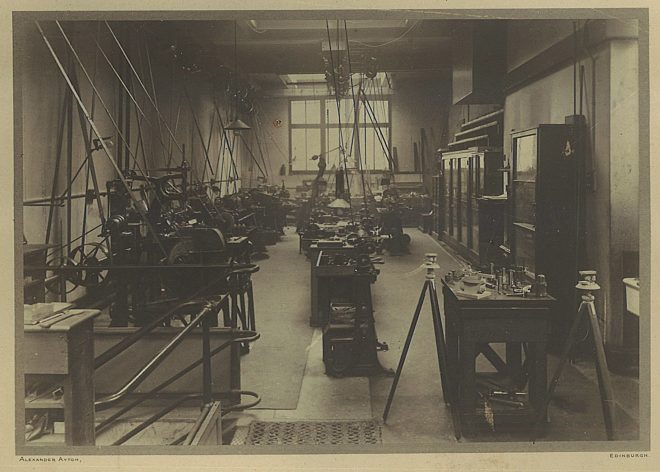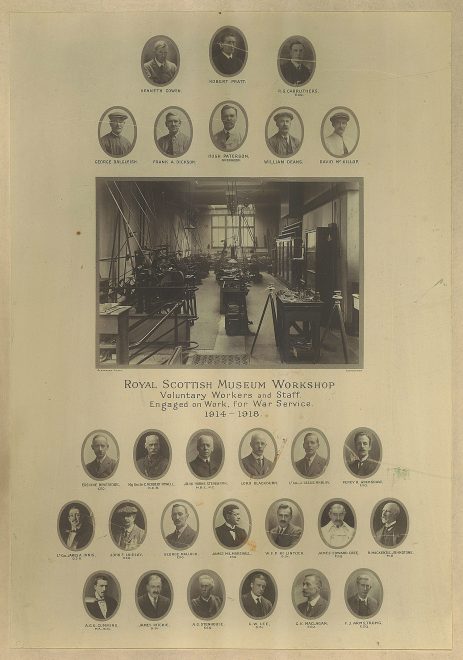“Do you know if we happen to have a note (or memorial anywhere) of any of our staff lost in the First World War?”
During the centenary of the First World War, we’ve had a number of enquiries from relatives tracing their military ancestors, but this was the first about our own staff. We haven’t located a roll of honour or a memorial so far, but we did find some information in the archives about the staff serving in the First World War which we would like to share with you.
Enquiries are rarely straightforward and this had some coincidences, ending up with an interesting addition to the Museum’s archive.
Royal Scottish Museum
The annual reports for 1916-17 and 1917-18 for the Royal Scottish Museum (now the National Museum of Scotland) state that:
“Four members of the administrative staff are absent on Military Service, and of the attendant staff, seven are serving in the Army or Navy”.
There is more information in the Director’s correspondence of the time, which mentions staff in, or called up for, military service in a number of letters referring to pay differentials, allowances, national insurance and exemptions. The staff register also lists the start date of military service for some staff.
The number of staff on military service was causing difficulties in the Museum, and the Director requested exemptions for W. Deans, 4th and 10th Territorial Battalion Royal Scots, as:
“the staff of the Museum had already contributed twelve men, which is an excessive proportion of the whole…” (14 January 1915)
For Norman D Cuthbertson, Librarian:
“…the depletion of the Staff by 14 members already on military service renders competent assistance from other quarters impossible.” (7 March 1916).
National Museum of Antiquities of Scotland
The National Museum of Antiquities was amalgamated with the Royal Scottish Museum in 1985. The only record we could locate was the minutes of the anniversary meeting of the Society of Antiquaries of Scotland on 30 November 1915, where it was noted:
“There is one another [sic] name to which the Council must refer in this connection, viz. that of Bugle-Major Wishart, the Museum attendant who had charge of the gallery on the top floor containing the Egyptian and Comparative collections … He was appointed bugle-major to the 5th Foreign Service Battalion Royal Scots, and fell at Gallipoli, on 12 May.” (Proceedings of the Society of Antiquaries of Scotland. Vol. 50, p6 2)
And:
“The staff of the Museum … had been further diminished … by the departure on active service of Mr. A.J. Edwards, the Assistant-Curator, who has been acting as a sergeant-major in the R.A.M.C. Territorial Force since the commencement of the war, and is presently stationed abroad, and of George Archibald, the Library attendant, who recently enlisted in the Royal Field Artillery.” (Proceedings of the Society of Antiquaries of Scotland, Vol. 50, p7)
Royal Scottish Museum Workshop
In addition to staff on military service, the museum workshop also assisted in the war effort as a result of a request approved with stipulations:
“for the services of the staff of the Royal Scottish Museum and the use of the Museum workshop and plant in order to assist with in the production of War Office requisites…” [29 May 2015]
A letter of 7 December 1915 from the Director acknowledges the receipt of nine badges from the Ministry of Munitions of War for the staff undertaking munitions work. For the remainder of the conflict, the workshop manufactured Field Artillery Fire Director stands, gun sights and certain interior parts of Howitzers. Despite holding badges, the Director still had to seek exemptions for George Malloch, “… a badged mechanic in the workshop”, and David McKillop:
“…I beg to state that this man is a badged Munition Worker, No. 31192 in our workshop here”.

Surprisingly, while the library staff were carrying out their research, Stuart Allan, Keeper of Scottish History and Archaeology, received information about the possible donation of a photograph commemorating the workshop and the staff and volunteers involved, and we are now pleased to have the original in the archive.

Commemorative photograph of staff from the Royal Scottish Museum Workshop. The 10 members of staff are Robert Pratt, George Dalgleish, Frank A. Dickson (Preparers), Hugh Paterson (Chief Mechanical Preparer and Overseer), William Deans (Attendant), David McKillop, Percy H. Grimshaw (then Assistant and later Keeper of Natural History), George Malloch, W. F. P. McLintoch (Assistant Geology Department) and James Ritchie (then Assistant and later Keeper of Natural History).
One omission from the photograph is the Director, Alexander Curle, who participated in the workshop three days a week from 15:30 until 19:00 in addition to his duties as a Special Constable.
There is still a lot we don’t know about the military service of our staff, and hopefully other relatives or members of staff may be able to help us fill in the gaps.
In memoriam
Lance Corporal James Spence died of his wounds at Gallipoli on 8 May 1915 and is buried in the Lancashire Landing Cemetery.
Bugle-Major Wishart, 5th Foreign Service Battalion Royal Scots, fell at Gallipoli on 12 May 1915.
John Spencer Jolly, Serjeant in the Royal Scots, 16th Btn. (Service No. 19813) killed in action on 1 July 1916 and listed on the Thiepval Memorial.
